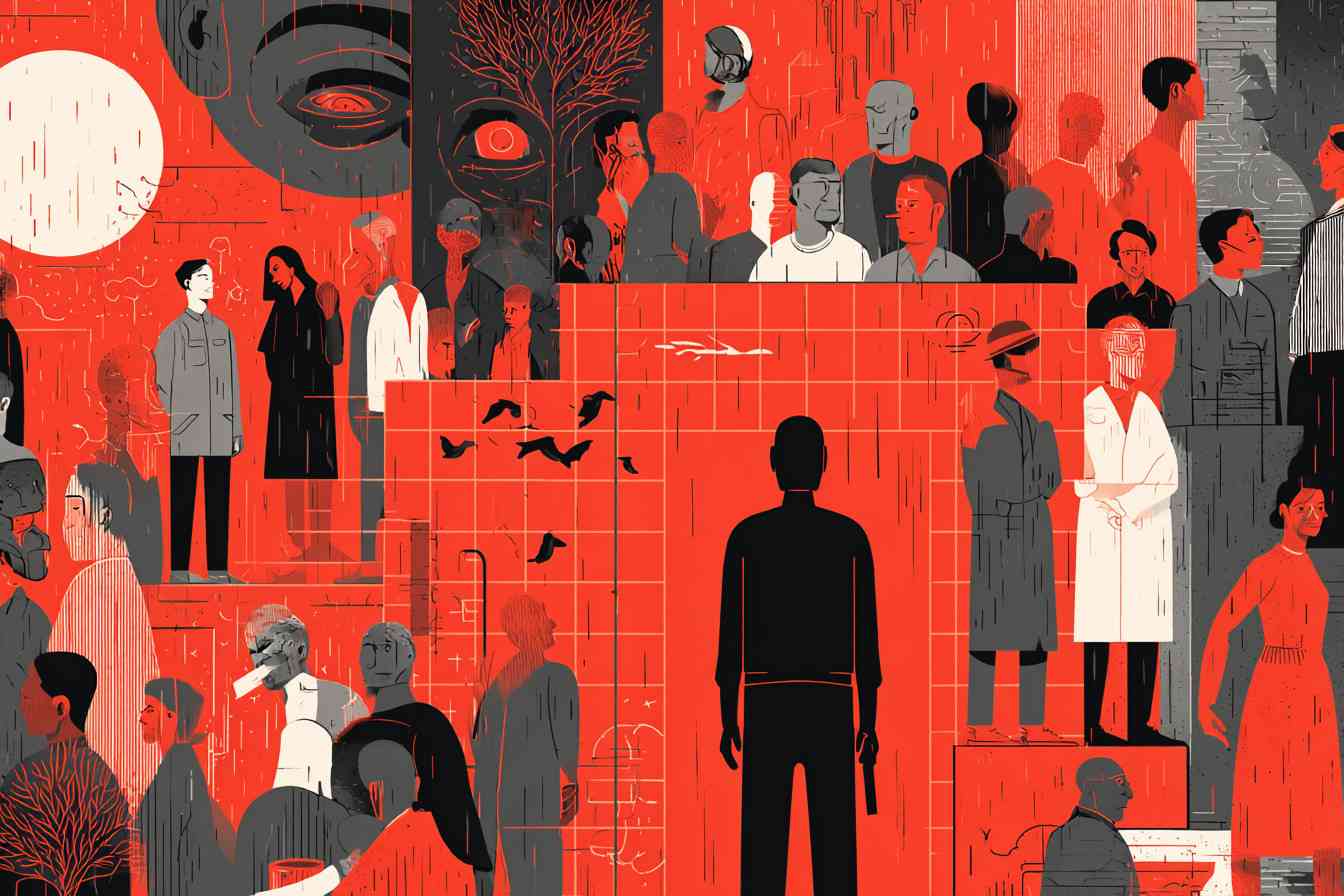Migration and crime in Western democracies: Overrepresentation of migrants with different cultural values

An issue governments try to avoid
In recent decades, Western Europe and North America have undergone unprecedented demographic shifts due to mass migration. Much of this migration comes from Islamic-majority countries in the Middle East, North Africa, and South Asia. While politicians often emphasize humanitarian obligations, economic benefits, or the virtues of diversity, one uncomfortable reality remains consistently downplayed: migrants, particularly those from Islamic backgrounds and illegal migrants, are statistically overrepresented in crime.
This is not a marginal phenomenon nor a myth fueled only by populist rhetoric. Government reports, national statistics offices, and independent researchers have repeatedly shown that migrant groups, especially young men from Muslim-majority regions, are disproportionately present in criminal cases ranging from theft to violent assault and sexual crime. The evidence is scattered across official reports, but when assembled, it paints a clear and worrying picture.
Evidence from the Netherlands
The Netherlands, long known for its liberal immigration policies, provides one of the clearest statistical windows into this problem.
A 2023 report by Statistics Netherlands (CBS), Integratie en Samenleven 2024, revealed that second-generation youths with two foreign-born parents were nearly three times more likely to be suspected of crime than native Dutch youths. Specifically, 3.4 percent of these second-generation youths were registered as crime suspects, compared to only 1.2 percent among native Dutch youths. The report further highlighted that youths of Moroccan, Caribbean, and Surinamese descent were especially overrepresented (Integratie en Samenleven 2024, CBS).
The situation is not limited to youths. In 2025, the Dutch Research and Documentation Centre (WODC) published a major study, Migratieachtergrond en nadelen in de strafrechtketen, which examined how migration background affects the entire justice chain. The study found that among adults, 45 percent of registered crime suspects had a migration background, but that share rose to 55 percent among those who eventually received prison sentences (Migratieachtergrond leidt tot nadelen in de strafrechtketen, WODC). Among minors the disparity was even sharper: while 46 percent of juvenile suspects had a migration background, 67 percent of those receiving youth detention were of migrant descent.
The WODC data also confirms that the overrepresentation cannot be explained away by poverty or unemployment alone, since the disparities persisted even after controlling for socioeconomic factors.
Another revealing set of data comes from the Central Agency for the Reception of Asylum Seekers (COA). In 2022, of the approximately 83,000 residents in COA shelters, 7 percent were involved in recorded incidents, and 3 percent were officially suspected of crimes. Within this group, certain nationalities were massively overrepresented: 44 percent of Algerians, 33 percent of Moroccans, and 31 percent of Tunisians in the shelters were registered as suspects (Overlast en criminaliteit houdt gelijke tred met aantal asielzoekers, Rijksoverheid). This demonstrates that a small but highly problematic subset of asylum seekers disproportionately contributes to crime and public disorder.
Taken together, the CBS, WODC, and COA findings illustrate a pattern that is both consistent and deeply troubling: migrants from Islamic-majority regions, and especially young men among them, are far more likely to be involved in criminality than native Dutch citizens.
The Swedish and German examples
The Netherlands is not unique. Sweden, often hailed internationally as a humanitarian model, has been forced by rising public concern to release data linking crime to migration. A landmark report by the Swedish National Council for Crime Prevention (Brå), Brottslighet bland personer födda i Sverige och i utlandet, showed that foreign-born individuals, particularly from the Middle East and North Africa, were overrepresented as crime suspects. Even after adjusting for factors such as income and education, the overrepresentation remained pronounced (Brå).
Germany has faced similar realities. Reports from the Bundeskriminalamt (BKA) in the annual Bundeslagebild Kriminalität im Kontext von Zuwanderung have consistently found that asylum seekers, refugees, and illegal migrants are disproportionately represented in violent crimes and sexual assaults. The most publicized example came after the 2015–2016 New Year’s Eve celebrations in Cologne, when hundreds of women reported mass sexual assaults by groups of young men of North African and Middle Eastern background. Although authorities initially downplayed the incidents, subsequent investigations confirmed the perpetrators’ backgrounds (Bundeslagebild Kriminalität im Kontext von Zuwanderung, Bundeskriminalamt).
These cases underline the wider European trend: cultural background and migration status correlate strongly with crime involvement.
The French banlieues and North African migration
France offers a historical perspective on how these problems evolve over decades. Large-scale migration from North Africa began in the 1960s, when labor shortages led French governments to recruit workers from Algeria, Morocco, and Tunisia. Many of these migrants settled permanently, and their descendants now form substantial communities in French cities.
Over time, however, the banlieues , suburban housing estates on the outskirts of Paris, Lyon, and Marseille , became synonymous with poverty, unemployment, and rising crime. A 2010 report by the French think tank Institut Montaigne, Banlieue de la République, noted that in many such neighborhoods, crime rates were dramatically higher than national averages, with a strong concentration of offenders of North African descent (Institut Montaigne).
The 2005 riots in Clichy-sous-Bois and other suburbs, sparked by the deaths of two teenagers of North African background fleeing police, revealed the depth of social breakdown. Thousands of cars were burned, shops looted, and public buildings attacked. Police reports showed that the majority of those arrested came from migrant backgrounds, primarily Islamic (Ministère de l’Intérieur).
France’s history demonstrates that migrant overrepresentation in crime is not a temporary “adjustment problem” but a long-term structural issue that worsens when integration fails.
The UK grooming gang scandals
In the United Kingdom, one of the most shocking examples of migrant-linked crime was the exposure of so-called grooming gangs. Beginning in towns like Rotherham, Rochdale, and Telford, investigations revealed that groups of predominantly Pakistani Muslim men had for decades groomed, sexually abused, and trafficked young white British girls.
The 2014 Jay Report, Independent Inquiry into Child Sexual Exploitation in Rotherham, concluded that at least 1,400 girls had been abused between 1997 and 2013, often with police and local authorities ignoring complaints for fear of being accused of racism (Independent Inquiry into Child Sexual Exploitation in Rotherham, Jay). Later inquiries found similar patterns in other towns, with thousands more victims.
The scandal illustrates not only criminal overrepresentation but also the way political correctness and fear of being labeled “Islamophobic” allowed systematic abuse to continue unchecked. This represents a double failure: by the perpetrators, and by the institutions meant to protect vulnerable citizens.
Illegal migrants and criminal economies
Illegal migrants, by definition residing outside legal frameworks, often face structural exclusion from employment and housing. As a result, they are more likely to become involved in informal economies, including drug trafficking, property crime, and black-market networks.
In France, the Ministry of the Interior has repeatedly highlighted that a large portion of arrests in Paris and Marseille involve foreigners, including illegal migrants from North Africa. Italy has similarly reported high levels of criminal involvement among irregular migrants, particularly in theft, robbery, and street-level violence (Rapporto sulla criminalità, Ministero dell’Interno).
The connection between illegal residence and crime is not coincidental: without legal rights or economic opportunities, crime often becomes a survival mechanism, but one that has dire consequences for host societies.
Cultural and religious dimensions
While socioeconomic disadvantage is often cited as the primary explanation, cultural and religious dimensions cannot be ignored. Migrants from Islamic-majority societies bring with them value systems shaped by patriarchal traditions, honor-based codes, and in some cases, a disregard for secular law.
This is evident in the persistence of honor killings, forced marriages, and gender-based violence within migrant communities. These crimes are virtually absent among native populations in Western Europe but are recurrent among families from Islamic backgrounds. The WODC has also noted that cultural differences contribute to misunderstandings and conflict with legal institutions, often exacerbating criminal justice involvement.
Moreover, cases like the Cologne assaults illustrate a different dimension: attitudes toward women and sexuality that clash fundamentally with Western norms. Anthropologist Unni Wikan in her work Sexual Violence and Migration has argued that such incidents are tied to cultural norms regarding masculinity, modesty, and power, rather than simply poverty or alienation.
Political denial and media censorship
Despite overwhelming evidence, political leaders and mainstream media have often refused to confront the issue directly. In Sweden, authorities long avoided publishing migration-linked crime data for fear of “fueling xenophobia.” In Germany, critics accused the government of deliberately minimizing the Cologne events to protect Chancellor Merkel’s open-border policy.
In the Netherlands, reports about COA shelter crime are often buried in bureaucratic language, downplaying the severity of the overrepresentation. Instead of acknowledging that certain national groups are disproportionately responsible for crime, officials emphasize “context” or “systemic disadvantages.”
This denial creates a dangerous gap between official narratives and public perception. Citizens see rising street crime, harassment, and unsafe neighborhoods, yet are told these are “isolated incidents.” Such dissonance erodes trust in government institutions and fuels populist backlash.
Social costs of migrant crime
The impact of migrant overrepresentation in crime extends beyond individual cases. Women in many European cities report feeling unsafe in public spaces. Public transport, once a hallmark of European urban life, has become associated with harassment and insecurity in areas with high migrant populations. Elderly citizens and families adjust their routines to avoid encounters with aggressive groups of young men.
The financial burden is equally severe. Governments spend billions annually on policing, court proceedings, prison systems, and “integration programs” designed to mitigate these problems. Resources that could strengthen education, healthcare, or housing are instead consumed by the fallout of uncontrolled migration and its criminal consequences.
The rise of organized crime networks involving migrants further destabilizes communities. From drug trafficking in the Netherlands to clan-based criminality in Sweden and Germany, entire urban areas risk becoming semi-lawless, eroding the rule of law.
Responsibility of governments and elites
Ultimately, responsibility does not lie solely with migrants who commit crimes. Western governments and elites bear enormous responsibility for designing and maintaining policies that created the conditions for overrepresentation. By opening borders without adequate controls, by refusing to vet migrants for criminal pasts, and by insisting that all cultures are “equally compatible” with Western systems, policymakers have produced a predictable security crisis.
The failure is twofold:
- Migrants who refuse to adapt to the laws and norms of their host societies.
- Governments that actively invited mass migration without realistic strategies for integration.
This is not an accidental byproduct of globalization but the consequence of deliberate political decisions.
Toward realistic solutions
If Western societies are to address migrant overrepresentation in crime, several steps are essential:
- Transparency in statistics: Governments must stop censoring or hiding data about crime and migration. Citizens have the right to know the true scale of the problem.
- Stricter immigration controls: Selective immigration policies, as practiced in countries like Japan, drastically reduce criminal risks. Migration from regions with high crime correlation must be tightly limited.
- Deportation of criminal migrants: Migrants who commit crimes, especially serious or violent ones, should lose their right to residence and face deportation. Anything less sends a message of impunity.
- Challenging cultural relativism: Western societies must reject the ideology that all cultural practices are equal. Honor-based violence, patriarchal domination, and hostility toward women’s rights must be recognized as incompatible with liberal democracy.
Without such measures, the trajectory is clear: rising crime, growing mistrust, and weakening social cohesion.
A reckoning long overdue
Not all migrants are criminals, and many contribute positively to Western societies. But refusing to acknowledge overrepresentation because “not everyone is guilty” is intellectually dishonest and politically reckless. Statistical overrepresentation means that even if only a minority are offenders, their impact on society is vastly disproportionate.
The evidence from the Netherlands, Sweden, Germany, France, and the UK is conclusive: migrants, particularly from Islamic-majority regions, are overrepresented in crime. Governments have known this for years, yet have deliberately avoided addressing it. The result is a society where ordinary citizens pay the price in insecurity, fear, and financial cost.
A reckoning is overdue. Western nations must decide whether to continue down the path of denial and destabilization, or to reclaim control of their borders, their justice systems, and their cultural integrity. Only by facing reality can they secure a stable and safe future.


















